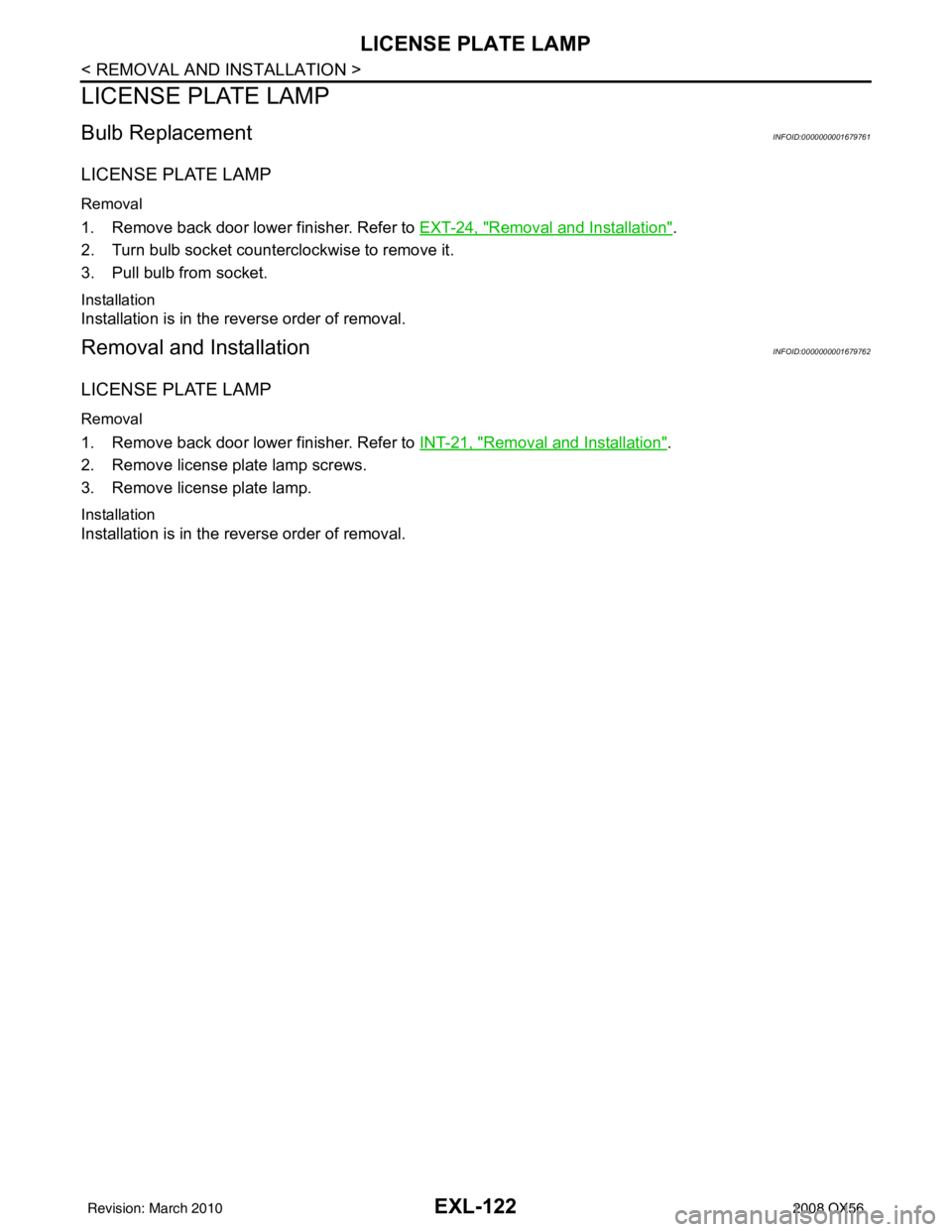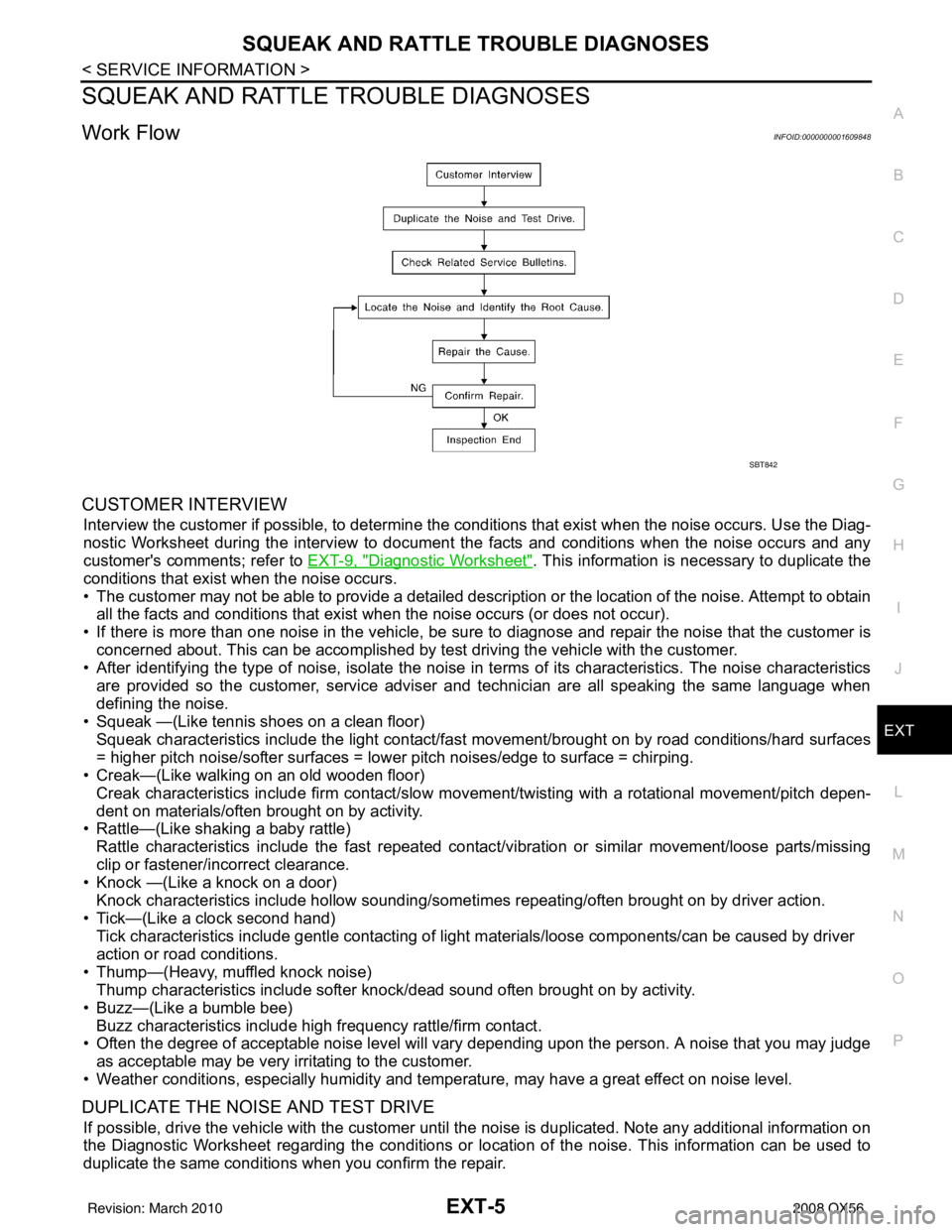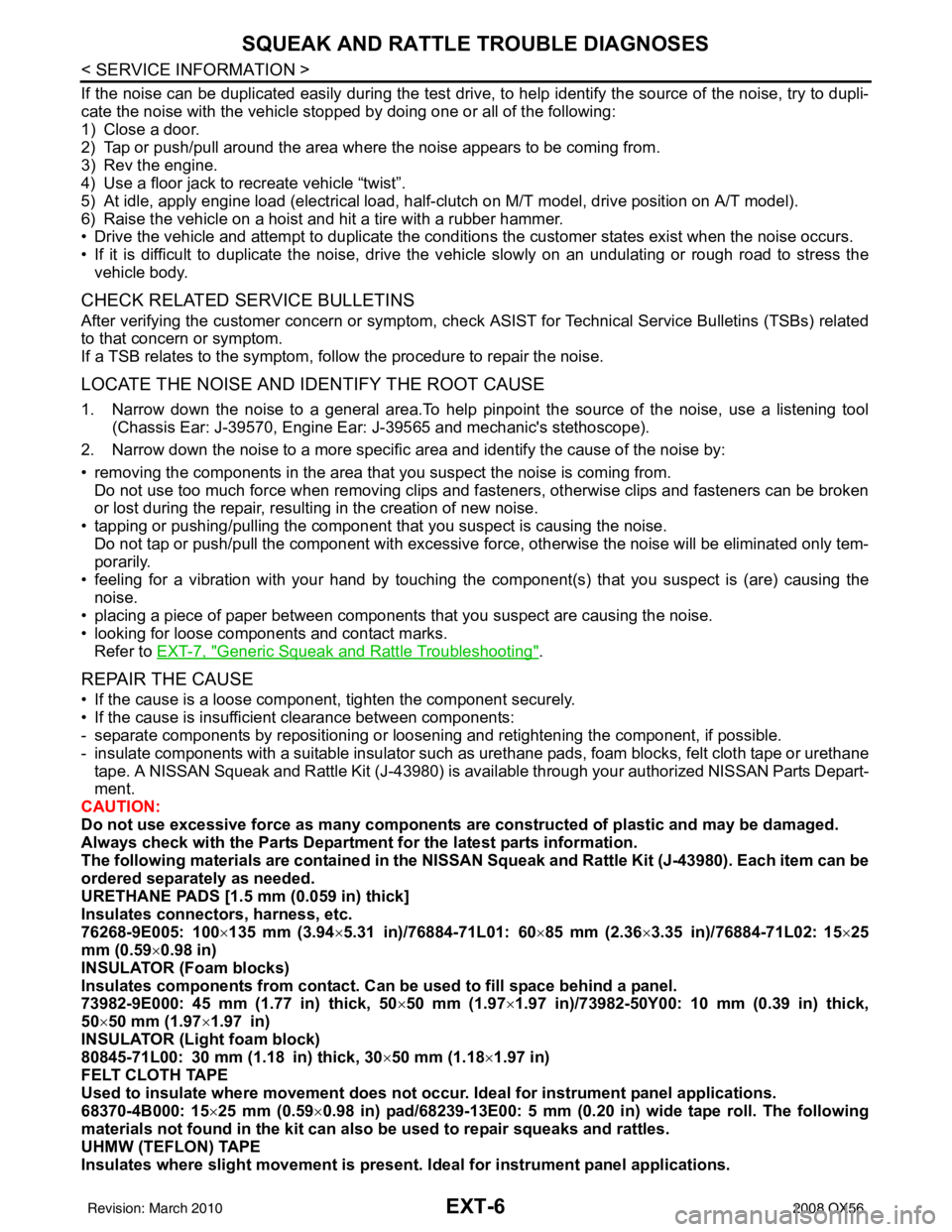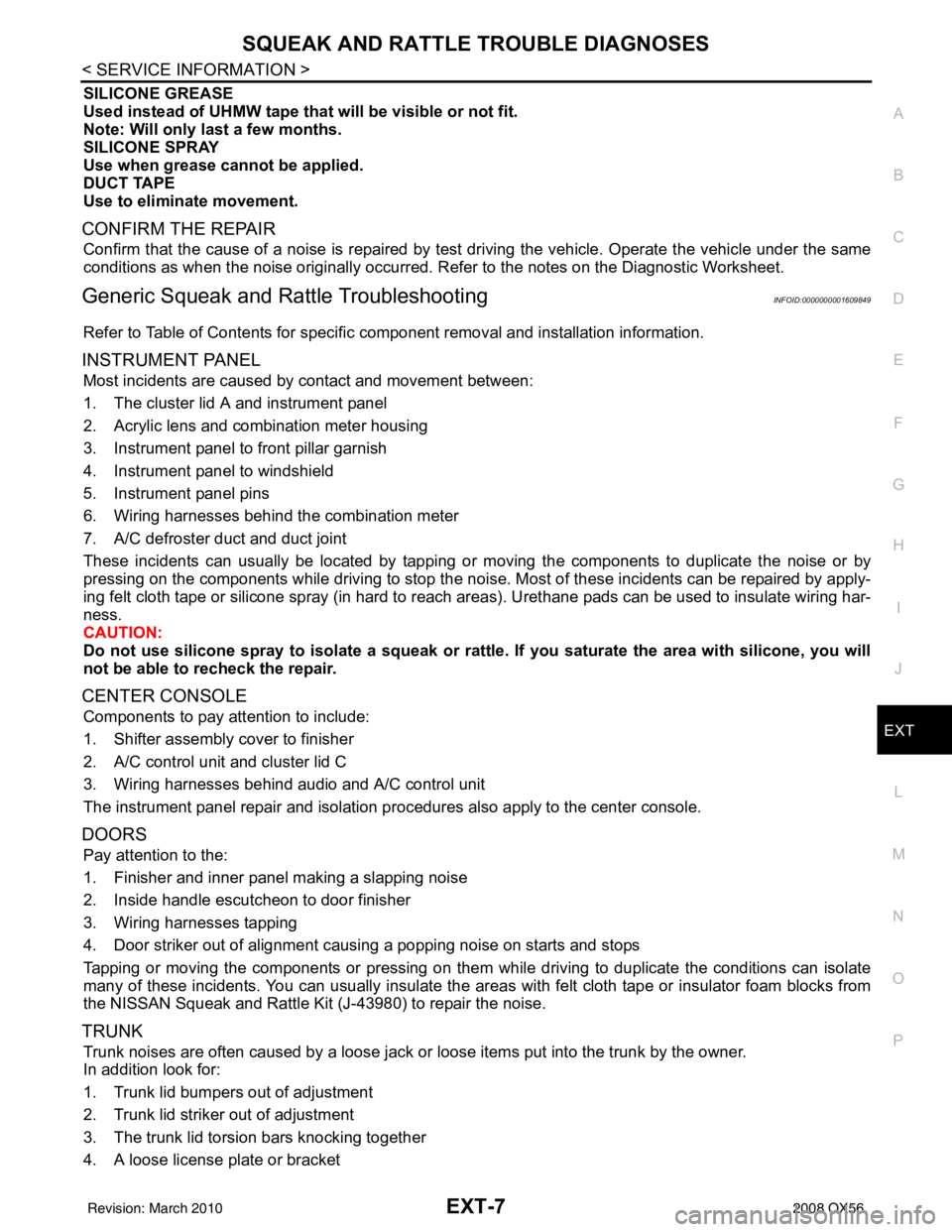2008 INFINITI QX56 door lock
[x] Cancel search: door lockPage 1027 of 4083
![INFINITI QX56 2008 Factory Service Manual DLK-234
< ON-VEHICLE REPAIR >[WITH INTELLIGENT KEY SYSTEM]
FRONT DOOR LOCK
8. Remove the TORX bolts (T30) (1), and separate the door lock
assembly (2) from the door.
9. While pulling the outside handl INFINITI QX56 2008 Factory Service Manual DLK-234
< ON-VEHICLE REPAIR >[WITH INTELLIGENT KEY SYSTEM]
FRONT DOOR LOCK
8. Remove the TORX bolts (T30) (1), and separate the door lock
assembly (2) from the door.
9. While pulling the outside handl](/manual-img/42/57030/w960_57030-1026.png)
DLK-234
< ON-VEHICLE REPAIR >[WITH INTELLIGENT KEY SYSTEM]
FRONT DOOR LOCK
8. Remove the TORX bolts (T30) (1), and separate the door lock
assembly (2) from the door.
9. While pulling the outside handle bracket, slide it toward the front of the vehicle to remove it and the door lock assembly as shown.
10. Disconnect the door lock actuator electrical connector.
11. Separate the outside handle cable connection (1) from the out- side handle bracket.
INSTALLATION
Installation is in the reverse order of removal.
CAUTION:
To install the key cylinder rod, be sure to rotate the key cylinder rod holder until a click is felt.
Disassembly and AssemblyINFOID:0000000001542673
DOOR KEY CYLINDER ASSEMBLY
Release the door key cylinder escutcheon pawls to remove the door key cylinder.Door lock assembly bolts 7.5 N·m (0.77 kg-m, 66 in-lb)
ALKIA0894ZZ
ALKIA0895ZZ
ALKIA0896ZZ
1. Door key cylinder assembly 2. Key cylinder assembly
3. Door key cylinder escutcheon
ALKIA0897ZZ
Revision: March 2010 2008 QX56
Page 1028 of 4083
![INFINITI QX56 2008 Factory Service Manual REAR DOOR LOCKDLK-235
< ON-VEHICLE REPAIR > [WITH INTELLIGENT KEY SYSTEM]
C
D
E
F
G H
I
J
L
M A
B
DLK
N
O P
REAR DOOR LOCK
Component StructureINFOID:0000000001539092
Removal and InstallationINFOID:000 INFINITI QX56 2008 Factory Service Manual REAR DOOR LOCKDLK-235
< ON-VEHICLE REPAIR > [WITH INTELLIGENT KEY SYSTEM]
C
D
E
F
G H
I
J
L
M A
B
DLK
N
O P
REAR DOOR LOCK
Component StructureINFOID:0000000001539092
Removal and InstallationINFOID:000](/manual-img/42/57030/w960_57030-1027.png)
REAR DOOR LOCKDLK-235
< ON-VEHICLE REPAIR > [WITH INTELLIGENT KEY SYSTEM]
C
D
E
F
G H
I
J
L
M A
B
DLK
N
O P
REAR DOOR LOCK
Component StructureINFOID:0000000001539092
Removal and InstallationINFOID:0000000001539093
REMOVAL
1. Remove the rear door window and rear door module assembly. Refer to GW-13, "Removal and Installa-
tion".
2. Remove door grommets, and remove outside handle nuts from grommet hole.
3. Remove outside handle.
4. Disconnect the door lock actuator connector.
5. Reach to separate outside handle rod connection.
INSTALLATION
Installation is in the reverse order of removal.
WIIA0892E
Revision: March 2010 2008 QX56
Page 1029 of 4083
![INFINITI QX56 2008 Factory Service Manual DLK-236
< ON-VEHICLE REPAIR >[WITH INTELLIGENT KEY SYSTEM]
BACK DOOR LOCK
BACK DOOR LOCK
Power Back Door OpenerINFOID:0000000001539094
Removal
1. Remove the LH luggage side upper. Refer to
INT-19, "R INFINITI QX56 2008 Factory Service Manual DLK-236
< ON-VEHICLE REPAIR >[WITH INTELLIGENT KEY SYSTEM]
BACK DOOR LOCK
BACK DOOR LOCK
Power Back Door OpenerINFOID:0000000001539094
Removal
1. Remove the LH luggage side upper. Refer to
INT-19, "R](/manual-img/42/57030/w960_57030-1028.png)
DLK-236
< ON-VEHICLE REPAIR >[WITH INTELLIGENT KEY SYSTEM]
BACK DOOR LOCK
BACK DOOR LOCK
Power Back Door OpenerINFOID:0000000001539094
Removal
1. Remove the LH luggage side upper. Refer to
INT-19, "Removal and Installation".
2. Disconnect the power back door motor electrical connector.
3. Disconnect the ball socket from the back door.
4. Remove the power back door motor assembly.
Installation
Installation is in the reverse order of removal.
WIIA0893E
Revision: March 2010 2008 QX56
Page 1030 of 4083
![INFINITI QX56 2008 Factory Service Manual BACK DOOR LOCKDLK-237
< ON-VEHICLE REPAIR > [WITH INTELLIGENT KEY SYSTEM]
C
D
E
F
G H
I
J
L
M A
B
DLK
N
O P
Door Lock AssemblyINFOID:0000000001539095
Removal
1. Remove the lower back door trim panel. INFINITI QX56 2008 Factory Service Manual BACK DOOR LOCKDLK-237
< ON-VEHICLE REPAIR > [WITH INTELLIGENT KEY SYSTEM]
C
D
E
F
G H
I
J
L
M A
B
DLK
N
O P
Door Lock AssemblyINFOID:0000000001539095
Removal
1. Remove the lower back door trim panel.](/manual-img/42/57030/w960_57030-1029.png)
BACK DOOR LOCKDLK-237
< ON-VEHICLE REPAIR > [WITH INTELLIGENT KEY SYSTEM]
C
D
E
F
G H
I
J
L
M A
B
DLK
N
O P
Door Lock AssemblyINFOID:0000000001539095
Removal
1. Remove the lower back door trim panel. Refer to INT-21, "Removal and Installation".
2. Remove the weathershields.
3. Disconnect the back door lock electrical connectors.
4. Remove the back door lock assembly.
5. Disconnect the back door glass lock electrical connector.
6. Remove the back door glass lock.
Installation
Installation is in the reverse order of removal.
WIIA0894E
Revision: March 2010 2008 QX56
Page 2050 of 4083

EXL-122
< REMOVAL AND INSTALLATION >
LICENSE PLATE LAMP
LICENSE PLATE LAMP
Bulb ReplacementINFOID:0000000001679761
LICENSE PLATE LAMP
Removal
1. Remove back door lower finisher. Refer to EXT-24, "Removal and Installation".
2. Turn bulb socket counterclockwise to remove it.
3. Pull bulb from socket.
Installation
Installation is in the reverse order of removal.
Removal and InstallationINFOID:0000000001679762
LICENSE PLATE LAMP
Removal
1. Remove back door lower finisher. Refer to INT-21, "Removal and Installation".
2. Remove license plate lamp screws.
3. Remove license plate lamp.
Installation
Installation is in the reverse order of removal.
Revision: March 2010 2008 QX56
Page 2058 of 4083

SQUEAK AND RATTLE TROUBLE DIAGNOSESEXT-5
< SERVICE INFORMATION >
C
DE
F
G H
I
J
L
M A
B
EXT
N
O P
SQUEAK AND RATTLE TROUBLE DIAGNOSES
Work FlowINFOID:0000000001609848
CUSTOMER INTERVIEW
Interview the customer if possible, to determine the conditions that exist when the noise occurs. Use the Diag-
nostic Worksheet during the interv iew to document the facts and conditions when the noise occurs and any
customer's comments; refer to EXT-9, "
Diagnostic Worksheet". This information is necessary to duplicate the
conditions that exist when the noise occurs.
• The customer may not be able to provide a detailed descr iption or the location of the noise. Attempt to obtain
all the facts and conditions that exist when the noise occurs (or does not occur).
• If there is more than one noise in the vehicle, be sure to diagnose and repair the noise that the customer is
concerned about. This can be accomplished by test driving the vehicle with the customer.
• After identifying the type of noise, isolate the noise in terms of its characteristics. The noise characteristics
are provided so the customer, service adviser and technician are all speaking the same language when
defining the noise.
• Squeak —(Like tennis shoes on a clean floor)
Squeak characteristics include the light contact/fast movement/brought on by road conditions/hard surfaces
= higher pitch noise/softer surfaces = lower pitch noises/edge to surface = chirping.
• Creak—(Like walking on an old wooden floor)
Creak characteristics include firm contact/slow mo vement/twisting with a rotational movement/pitch depen-
dent on materials/often brought on by activity.
• Rattle—(Like shaking a baby rattle)
Rattle characteristics include the fast repeated contac t/vibration or similar movement/loose parts/missing
clip or fastener/incorrect clearance.
• Knock —(Like a knock on a door)
Knock characteristics include hollow sounding/someti mes repeating/often brought on by driver action.
• Tick—(Like a clock second hand) Tick characteristics include gentle contacting of li ght materials/loose components/can be caused by driver
action or road conditions.
• Thump—(Heavy, muffled knock noise) Thump characteristics include softer k nock/dead sound often brought on by activity.
• Buzz—(Like a bumble bee)
Buzz characteristics include high frequency rattle/firm contact.
• Often the degree of acceptable noise level will vary depending upon the person. A noise that you may judge as acceptable may be very irritating to the customer.
• Weather conditions, especially humidity and temperature, may have a great effect on noise level.
DUPLICATE THE NOISE AND TEST DRIVE
If possible, drive the vehicle with the customer until the noise is duplicated. Note any additional information on
the Diagnostic Worksheet regarding the conditions or lo cation of the noise. This information can be used to
duplicate the same conditions when you confirm the repair.
SBT842
Revision: March 2010 2008 QX56
Page 2059 of 4083

EXT-6
< SERVICE INFORMATION >
SQUEAK AND RATTLE TROUBLE DIAGNOSES
If the noise can be duplicated easily during the test drive, to help identify the source of the noise, try to dupli-
cate the noise with the vehicle stopped by doing one or all of the following:
1) Close a door.
2) Tap or push/pull around the area where the noise appears to be coming from.
3) Rev the engine.
4) Use a floor jack to recreate vehicle “twist”.
5) At idle, apply engine load (electrical load, half-clutch on M/T model, drive position on A/T model).
6) Raise the vehicle on a hoist and hit a tire with a rubber hammer.
• Drive the vehicle and attempt to duplicate the conditions the customer states exist when the noise occurs.
• If it is difficult to duplicate the noise, drive the v ehicle slowly on an undulating or rough road to stress the
vehicle body.
CHECK RELATED SERVICE BULLETINS
After verifying the customer concern or symptom, chec k ASIST for Technical Service Bulletins (TSBs) related
to that concern or symptom.
If a TSB relates to the symptom, follo w the procedure to repair the noise.
LOCATE THE NOISE AND IDENTIFY THE ROOT CAUSE
1. Narrow down the noise to a general area.To help pinpoint the source of the noise, use a listening tool
(Chassis Ear: J-39570, Engine Ear: J-39565 and mechanic's stethoscope).
2. Narrow down the noise to a more specific area and identify the cause of the noise by:
• removing the components in the area that you suspect the noise is coming from.
Do not use too much force when removing clips and fasteners, otherwise clips and fasteners can be broken
or lost during the repair, resulting in the creation of new noise.
• tapping or pushing/pulling the component that you suspect is causing the noise.
Do not tap or push/pull the component with excessive force, otherwise the noise will be eliminated only tem-
porarily.
• feeling for a vibration with your hand by touching the component(s) that you suspect is (are) causing the
noise.
• placing a piece of paper between components that you suspect are causing the noise.
• looking for loose components and contact marks. Refer to EXT-7, "
Generic Squeak and Rattle Troubleshooting".
REPAIR THE CAUSE
• If the cause is a loose component, tighten the component securely.
• If the cause is insufficient clearance between components:
- separate components by repositioning or loos ening and retightening the component, if possible.
- insulate components with a suitable insulator such as urethane pads, foam blocks, felt cloth tape or urethane tape. A NISSAN Squeak and Rattle Kit (J-43980) is av ailable through your authorized NISSAN Parts Depart-
ment.
CAUTION:
Do not use excessive force as many components are constructed of plastic and may be damaged.
Always check with the Parts Department for the latest parts information.
The following materials are contained in the NISSAN Squeak and Rattle Kit (J-43980). Each item can be
ordered separately as needed.
URETHANE PADS [1.5 mm (0.059 in) thick]
Insulates connectors, harness, etc.
76268-9E005: 100 ×135 mm (3.94× 5.31 in)/76884-71L01: 60 ×85 mm (2.36 ×3.35 in)/76884-71L02: 15 ×25
mm (0.59× 0.98 in)
INSULATOR (Foam blocks)
Insulates components from contact. Can be used to fill space behind a panel.
73982-9E000: 45 mm (1.77 in) thick, 50 ×50 mm (1.97 ×1.97 in)/73982-50Y00: 10 mm (0.39 in) thick,
50× 50 mm (1.97 ×1.97 in)
INSULATOR (Light foam block)
80845-71L00: 30 mm (1.18 in) thick, 30 ×50 mm (1.18 ×1.97 in)
FELT CLOTH TAPE
Used to insulate where movemen t does not occur. Ideal for instrument panel applications.
68370-4B000: 15 ×25 mm (0.59× 0.98 in) pad/68239-13E00: 5 mm (0.20 in ) wide tape roll. The following
materials not found in the kit can also be used to repair squeaks and rattles.
UHMW (TEFLON) TAPE
Insulates where slight movement is present. Ideal for inst rument panel applications.
Revision: March 2010 2008 QX56
Page 2060 of 4083

SQUEAK AND RATTLE TROUBLE DIAGNOSESEXT-7
< SERVICE INFORMATION >
C
DE
F
G H
I
J
L
M A
B
EXT
N
O P
SILICONE GREASE
Used instead of UHMW tape that will be visible or not fit.
Note: Will only last a few months.
SILICONE SPRAY
Use when grease cannot be applied.
DUCT TAPE
Use to eliminate movement.
CONFIRM THE REPAIR
Confirm that the cause of a noise is repaired by test driving the vehicle. Operate the vehicle under the same
conditions as when the noise originally occurred. Refer to the notes on the Diagnostic Worksheet.
Generic Squeak and Rattle TroubleshootingINFOID:0000000001609849
Refer to Table of Contents for specific component removal and installation information.
INSTRUMENT PANEL
Most incidents are caused by contact and movement between:
1. The cluster lid A and instrument panel
2. Acrylic lens and combination meter housing
3. Instrument panel to front pillar garnish
4. Instrument panel to windshield
5. Instrument panel pins
6. Wiring harnesses behind the combination meter
7. A/C defroster duct and duct joint
These incidents can usually be located by tapping or moving the components to duplicate the noise or by
pressing on the components while driving to stop the noi se. Most of these incidents can be repaired by apply-
ing felt cloth tape or silicone spray (in hard to reach areas). Urethane pads can be used to insulate wiring har-
ness.
CAUTION:
Do not use silicone spray to isolate a squeak or ra ttle. If you saturate the area with silicone, you will
not be able to recheck the repair.
CENTER CONSOLE
Components to pay attention to include:
1. Shifter assembly cover to finisher
2. A/C control unit and cluster lid C
3. Wiring harnesses behind audio and A/C control unit
The instrument panel repair and isolation pr ocedures also apply to the center console.
DOORS
Pay attention to the:
1. Finisher and inner panel making a slapping noise
2. Inside handle escutcheon to door finisher
3. Wiring harnesses tapping
4. Door striker out of alignment causing a popping noise on starts and stops
Tapping or moving the components or pressing on them while driving to duplicate the conditions can isolate
many of these incidents. You can usually insulate the ar eas with felt cloth tape or insulator foam blocks from
the NISSAN Squeak and Rattle Kit (J-43980) to repair the noise.
TRUNK
Trunk noises are often caused by a loose jack or loose items put into the trunk by the owner.
In addition look for:
1. Trunk lid bumpers out of adjustment
2. Trunk lid striker out of adjustment
3. The trunk lid torsion bars knocking together
4. A loose license plate or bracket
Revision: March 2010 2008 QX56